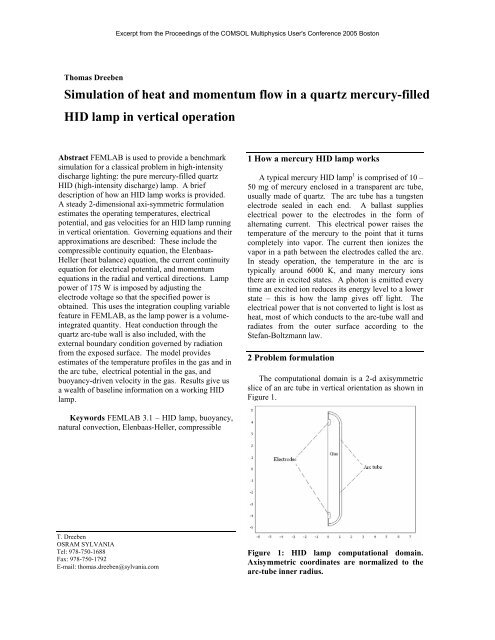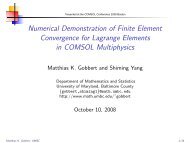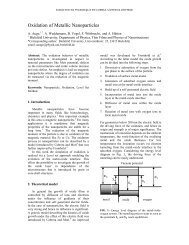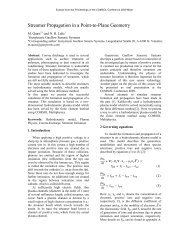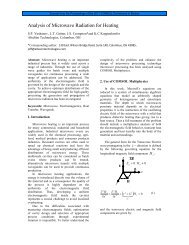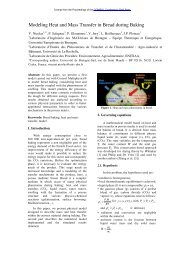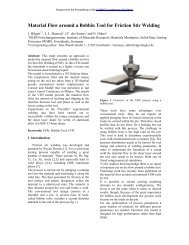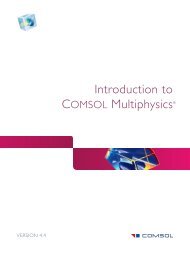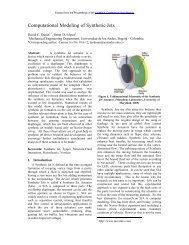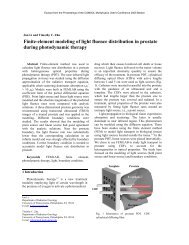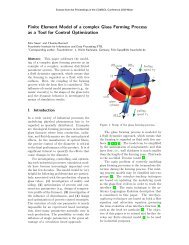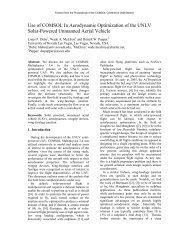Simulation of heat and momentum flow in a quartz mercury ... - Comsol
Simulation of heat and momentum flow in a quartz mercury ... - Comsol
Simulation of heat and momentum flow in a quartz mercury ... - Comsol
- No tags were found...
You also want an ePaper? Increase the reach of your titles
YUMPU automatically turns print PDFs into web optimized ePapers that Google loves.
Excerpt from the Proceed<strong>in</strong>gs <strong>of</strong> the COMSOL Multiphysics User's Conference 2005 BostonThomas Dreeben<strong>Simulation</strong> <strong>of</strong> <strong>heat</strong> <strong>and</strong> <strong>momentum</strong> <strong>flow</strong> <strong>in</strong> a <strong>quartz</strong> <strong>mercury</strong>-filledHID lamp <strong>in</strong> vertical operationAbstract FEMLAB is used to provide a benchmarksimulation for a classical problem <strong>in</strong> high-<strong>in</strong>tensitydischarge light<strong>in</strong>g: the pure <strong>mercury</strong>-filled <strong>quartz</strong>HID (high-<strong>in</strong>tensity discharge) lamp. A briefdescription <strong>of</strong> how an HID lamp works is provided.A steady 2-dimensional axi-symmetric formulationestimates the operat<strong>in</strong>g temperatures, electricalpotential, <strong>and</strong> gas velocities for an HID lamp runn<strong>in</strong>g<strong>in</strong> vertical orientation. Govern<strong>in</strong>g equations <strong>and</strong> theirapproximations are described: These <strong>in</strong>clude thecompressible cont<strong>in</strong>uity equation, the Elenbaas-Heller (<strong>heat</strong> balance) equation, the current cont<strong>in</strong>uityequation for electrical potential, <strong>and</strong> <strong>momentum</strong>equations <strong>in</strong> the radial <strong>and</strong> vertical directions. Lamppower <strong>of</strong> 175 W is imposed by adjust<strong>in</strong>g theelectrode voltage so that the specified power isobta<strong>in</strong>ed. This uses the <strong>in</strong>tegration coupl<strong>in</strong>g variablefeature <strong>in</strong> FEMLAB, as the lamp power is a volume<strong>in</strong>tegratedquantity. Heat conduction through the<strong>quartz</strong> arc-tube wall is also <strong>in</strong>cluded, with theexternal boundary condition governed by radiationfrom the exposed surface. The model providesestimates <strong>of</strong> the temperature pr<strong>of</strong>iles <strong>in</strong> the gas <strong>and</strong> <strong>in</strong>the arc tube, electrical potential <strong>in</strong> the gas, <strong>and</strong>buoyancy-driven velocity <strong>in</strong> the gas. Results give usa wealth <strong>of</strong> basel<strong>in</strong>e <strong>in</strong>formation on a work<strong>in</strong>g HIDlamp.1 How a <strong>mercury</strong> HID lamp worksA typical <strong>mercury</strong> HID lamp 1 is comprised <strong>of</strong> 10 –50 mg <strong>of</strong> <strong>mercury</strong> enclosed <strong>in</strong> a transparent arc tube,usually made <strong>of</strong> <strong>quartz</strong>. The arc tube has a tungstenelectrode sealed <strong>in</strong> each end. A ballast supplieselectrical power to the electrodes <strong>in</strong> the form <strong>of</strong>alternat<strong>in</strong>g current. This electrical power raises thetemperature <strong>of</strong> the <strong>mercury</strong> to the po<strong>in</strong>t that it turnscompletely <strong>in</strong>to vapor. The current then ionizes thevapor <strong>in</strong> a path between the electrodes called the arc.In steady operation, the temperature <strong>in</strong> the arc istypically around 6000 K, <strong>and</strong> many <strong>mercury</strong> ionsthere are <strong>in</strong> excited states. A photon is emitted everytime an excited ion reduces its energy level to a lowerstate – this is how the lamp gives <strong>of</strong>f light. Theelectrical power that is not converted to light is lost as<strong>heat</strong>, most <strong>of</strong> which conducts to the arc-tube wall <strong>and</strong>radiates from the outer surface accord<strong>in</strong>g to theStefan-Boltzmann law.2 Problem formulationThe computational doma<strong>in</strong> is a 2-d axisymmetricslice <strong>of</strong> an arc tube <strong>in</strong> vertical orientation as shown <strong>in</strong>Figure 1.Keywords FEMLAB 3.1 – HID lamp, buoyancy,natural convection, Elenbaas-Heller, compressibleT. DreebenOSRAM SYLVANIATel: 978-750-1688Fax: 978-750-1792E-mail: thomas.dreeben@sylvania.comFigure 1: HID lamp computational doma<strong>in</strong>.Axisymmetric coord<strong>in</strong>ates are normalized to thearc-tube <strong>in</strong>ner radius.
Excerpt from the Proceed<strong>in</strong>gs <strong>of</strong> the COMSOL Multiphysics User's Conference 2005 BostonThe doma<strong>in</strong> <strong>in</strong>cludes two electrodes withproperties <strong>of</strong> tungsten, an arc tube with properties <strong>of</strong><strong>quartz</strong>, <strong>and</strong> an enclosed gas with properties <strong>of</strong><strong>mercury</strong> vapor.A mesh <strong>of</strong> 2484 first-order Lagrangian elementsis used <strong>and</strong> shown <strong>in</strong> Figure 2. Ref<strong>in</strong>ement aroundthe electrodes is needed to help assure convergence,as the spatial temperature gradients are steepest there.Figure 2: Mesh for the gas, electrodes, <strong>and</strong> arctubeSome approximations are used here to simplifythe problem:• Although HID lamps run on alternat<strong>in</strong>gcurrent, the FEMLAB model isconstructed for direct current so that asteady simulation can be performed.• Radiation is characterized as a localtemperature-dependent loss term <strong>in</strong> theElenbaas-Heller (energy) equation. Thenon-local effect <strong>of</strong> absorption isneglected <strong>in</strong> the model.• Heat transfer between the gas <strong>and</strong> theelectrodes is mischaracterized <strong>in</strong> themodel as pure <strong>heat</strong> conduction. In HIDlamps, there is a non-neutral plasmas<strong>heat</strong>h near each electrode <strong>in</strong> whichmany more processes govern the <strong>heat</strong>transfer – all <strong>of</strong> these additionalprocesses are neglected <strong>in</strong> the model.• Spatial pressure variation is <strong>in</strong>corporatedfor buoyancy, but neglected <strong>in</strong> the idealgas law.• Although compressibility is <strong>in</strong>cluded <strong>in</strong>the mass cont<strong>in</strong>uity equation, it isneglected <strong>in</strong> the viscous stress terms <strong>of</strong>the <strong>momentum</strong> equations. We assumethat stresses associated with dilitation aresmall compared with stresses associatedwith shear.The ma<strong>in</strong> aspects <strong>of</strong> the mathematical formulation<strong>of</strong> the problem are as follows: The govern<strong>in</strong>gequations are those <strong>of</strong> natural convection coupledwith <strong>heat</strong> transfer <strong>and</strong> electrical current cont<strong>in</strong>uity 2,3,4 .For velocity vector u r , gas density ρ , <strong>and</strong> pressurep , the steady <strong>momentum</strong> equations <strong>in</strong> the radial ( r )<strong>and</strong> vertical ( z ) directions are expressed <strong>in</strong> vectorform asr r r r r r r rρu ∇ u =− ∇{p −{ρg +∇ ( μ∇u).123 14243 (1)convectionpressuregradientbuoyancyviscous stressThe steady, compressible mass cont<strong>in</strong>uity equation isr r∇ ( ρu ) = 0.(2)Velocity boundary conditions are no-slip <strong>and</strong>impermiability at all solid surfaces, <strong>and</strong> naturalsymmetry conditions along the axis. Because thespatial pressure variation is smaller than the lamppressure by 5 orders <strong>of</strong> magnitude, pressure isassumed to be contant <strong>in</strong> the ideal gas law which thenpecomesρ T = constant.(3)For electrical potential φ <strong>and</strong> temperature T , theenergy balance <strong>in</strong> the gas is expressed by theElenbaas-Heller equation:r r r r rρcu∇ T=∇ κ∇ T + σ ∇φ− q2( ) {radp14243 14243 123convection conduction electrical<strong>heat</strong> sourceradiation<strong>heat</strong> s<strong>in</strong>k(4)Heat also conducts through the arc tube <strong>and</strong>electrodes with the steady <strong>heat</strong>-condcution equation,us<strong>in</strong>g thermal conductivities that are appropriate to<strong>quartz</strong> <strong>and</strong> tungsten respectively. Heat leaves thesystem with the Stefan-Boltzmann law as theboundary condition on the outer arc-tube surface. Asmall amount <strong>of</strong> <strong>heat</strong> also conducts away from theouter electrode ends, us<strong>in</strong>g a semi-empirical mixedboundary condition. The source <strong>and</strong> s<strong>in</strong>k terms <strong>of</strong>Eq. (4) are very strong functions <strong>of</strong> temperature,because <strong>of</strong> the temperature dependence <strong>of</strong> electricalconductivity σ <strong>and</strong> volumetric radiation qrad. For apure <strong>mercury</strong> lamp runn<strong>in</strong>g at 3.78 atm <strong>of</strong> pressure,these terms are approximated <strong>in</strong> the model with thefollow<strong>in</strong>g semi-empirical expressions: 50.75 −55820/Tσ = 1070 T e ,142.69×10(5)−86000/Tq = e .radTThe electrical potential φ (which is also voltage) isdeterm<strong>in</strong>ed from the current cont<strong>in</strong>uity equation
Excerpt from the Proceed<strong>in</strong>gs <strong>of</strong> the COMSOL Multiphysics User's Conference 2005 Bostonr r∇ ∇ =( σ φ) 0,(6)with a coupl<strong>in</strong>g to the temperature through theelectrical conductivity σ . The boundary conditionson φ are no-flux along the <strong>in</strong>ner arc-tube surface <strong>and</strong>lamp axis, <strong>and</strong> constant values at the electrodes.These electrode values impose a voltage differenceacross the lamp which drives the Elenbaas-Hellerequation through the <strong>heat</strong>-source term <strong>of</strong> Eq. (4).Mathematically, the electrode values <strong>of</strong> φ aredeterm<strong>in</strong>ed by allow<strong>in</strong>g them to float to whatevervalue enables the satisfaction <strong>of</strong> the global <strong>in</strong>tergralconstra<strong>in</strong>tr 2P= σ ∇φdV,∫Lamp(7)where P = 175 W is the specified power <strong>of</strong> thelamp.Equations (1)-(6) are recast <strong>in</strong> a form with alldimensionless variables, <strong>and</strong> then implemented <strong>in</strong>FEMLAB us<strong>in</strong>g its general form. This dimensionlessformulation is straightforward except for thetreatment <strong>of</strong> the potential φ . Here a dimensionlessvariable φ % is def<strong>in</strong>ed by scal<strong>in</strong>g the potential with itsunknown value at the electrodes. This way, theelectrode boundary conditions on the dimensionless% . Then% φ are the simple Dirichlet condition φ =± 1the <strong>in</strong>tegral constra<strong>in</strong>t <strong>of</strong> Eq. (7) is imposed us<strong>in</strong>g the<strong>in</strong>tegration coupl<strong>in</strong>g variable feature, <strong>and</strong> is then usedto determ<strong>in</strong>e the dimensionless parameter thatprecedes the <strong>heat</strong>-source term <strong>in</strong> the dimensionlessversion <strong>of</strong> Eqs. (4). The dimensionless system coded<strong>in</strong>to FEMLAB is a full mathematical equivalent toEqs. (1) - (7).3 Convergence <strong>and</strong> model outputBecause <strong>of</strong> the coupl<strong>in</strong>g <strong>and</strong> strong temperaturedependence <strong>of</strong> the electrical conductivity σ <strong>and</strong> theradiation qrad, some care is required <strong>in</strong> the <strong>in</strong>itialconditions to obta<strong>in</strong> convergence. Convergence isobta<strong>in</strong>ed by build<strong>in</strong>g up the computation <strong>in</strong> 3 stages,each comput<strong>in</strong>g a larger portion <strong>of</strong> the fully-coupledproblem. All <strong>of</strong> this is programmed <strong>in</strong> a MATLAB.m file. The <strong>in</strong>itial fields are a quiescent velocityfield, a gas temperature pr<strong>of</strong>ile that is parabolic <strong>in</strong> theradial direction, <strong>and</strong> a potential pr<strong>of</strong>ile that is l<strong>in</strong>ear<strong>in</strong> the axial direction. The first stage is to solve Eq.(6) (current cont<strong>in</strong>uity) for the potential φ with allother variables held fixed. In the second stage, theoutput <strong>of</strong> the first stage is fed <strong>in</strong>to a coupled,unsteady simulation <strong>of</strong> Eqs. (4) <strong>and</strong> (6) together, withthe <strong>momentum</strong> <strong>and</strong> mass cont<strong>in</strong>uity equations stillheld fixed with zero velocity field. This pair <strong>of</strong>equations is run until the solution for temperature T<strong>and</strong> potential φ is approximately steady. The thirdstage is to solve the full coupled set <strong>of</strong> equations <strong>in</strong> asteady simulation, start<strong>in</strong>g from the output <strong>of</strong> thesecond stage. For this stage, the model must beconverted from the general form to the weak form, toassure that FEMLAB <strong>in</strong>cludes Eq. (7) when itcomputes the Jacobian. This nonlocal Jacobianmakes the simulation rather computationally<strong>in</strong>tensive. Nevertheless, the simulation with all 3stages reaches a fully-coupled steady solution <strong>in</strong> justunder 2 m<strong>in</strong>tues.The primary output <strong>of</strong> the simulation is atemperature <strong>and</strong> velocity map, as shown <strong>in</strong> Figure 3.Figure 3: Temperature pr<strong>of</strong>ile with velocityvectors. Spatial dimensions are normalized by thearc-tube <strong>in</strong>ner radius.The radial temperature gradient gives rise to a densitygradient, which makes the gas <strong>in</strong> the center muchlighter than the gas near the walls. This creates abuoyancy force which makes the gas rise <strong>in</strong> the center<strong>and</strong> fall along the arc-tube wall.Halfway between the electrodes, the temperature<strong>and</strong> velocity pr<strong>of</strong>iles are shown <strong>in</strong> Figure 4 <strong>and</strong>Figure 5 respectively.
Excerpt from the Proceed<strong>in</strong>gs <strong>of</strong> the COMSOL Multiphysics User's Conference 2005 BostonFigure 4: Temperature pr<strong>of</strong>ile versus normalizedlamp radius, halfway between the electrodes.Figure 6: Electrical potential (Voltage) throughoutthe lamp.The predicted voltage across the electrodes <strong>of</strong> 106.5V is lower than the real lamp voltage by 20%, due tothe model’s neglect <strong>of</strong> electrode plasma effects <strong>and</strong>their associated cathode fall. The slight verticalasymmetry <strong>in</strong> potential is an <strong>in</strong>direct result <strong>of</strong> theconvection: Convection causes a slight verticalasymmetry <strong>in</strong> the temperature pr<strong>of</strong>ile <strong>of</strong> Figure 3.This <strong>in</strong>fluences the electrical potential through theappearance <strong>of</strong> electrical conductivity σ <strong>in</strong> Eq. (6).A pressure map, referenced to zero at the lowerelectrode tip, is shown <strong>in</strong> Figure 7.Figure 5: Vertical velocity pr<strong>of</strong>ile versusnormalized lamp radius, halfway between theelectrodes.Historically, measurement <strong>of</strong> temperature pr<strong>of</strong>iles <strong>in</strong><strong>mercury</strong> lamps show that the pr<strong>of</strong>iles such as Figure4 are generally accurate to with<strong>in</strong> 5 or 10%. Thereare no direct measurements <strong>of</strong> gas velocity pr<strong>of</strong>iles,so Figure 5 gives us an approximation that would beunavailable without model<strong>in</strong>g: The maximumvelocity for a lamp <strong>of</strong> these dimensions is <strong>of</strong> order 10– 20 cm /sec. Note that the velocity upward <strong>in</strong> thecenter greatly exceeds the velocity downward nearthe walls. This is partly because the gas <strong>in</strong> the centeris much less dense, <strong>and</strong> partly because the gas <strong>in</strong> thecenter occupies less volume than the gas near thewall due to the axisymmetry <strong>of</strong> the arc tube.The electrical potential is shown <strong>in</strong> Figure 6.Figure 7: Pressure referenced to zero at the lowerelectrode tipThis characterizes the scale <strong>of</strong> the buoyancy forces<strong>and</strong> shows that the pressure difference required tosupport the weight <strong>of</strong> the gas is about 2 Pa.ConclusionF<strong>in</strong>ite-element analysis us<strong>in</strong>g FEMLAB is anefficient method for obta<strong>in</strong><strong>in</strong>g basel<strong>in</strong>e <strong>in</strong>formationon the work<strong>in</strong>g <strong>of</strong> a <strong>mercury</strong>-filled HID lamp.
Excerpt from the Proceed<strong>in</strong>gs <strong>of</strong> the COMSOL Multiphysics User's Conference 2005 BostonReferences1. Elenbaas W., The High Pressure MercuryVapour Discharge, North-Holl<strong>and</strong>,Amsterdam, 19512. Zollweg, R. J., Convection <strong>in</strong> vertical highpressure<strong>mercury</strong> arcs, J. Appl. Phys., 49(3),1077-1091 (1978).3. Lowke, J. J., Calculated properties <strong>of</strong>vertical arcs stabilized by naturalconvection, J. Appl. Phys., 50(1), 147-157,(1979).4. Shyy, W., Effects <strong>of</strong> convection <strong>and</strong> electricfield on therm<strong>of</strong>luid transport <strong>in</strong> horizontalhigh-pressure <strong>mercury</strong> arcs, J. Appl. Phys.,67(4), 1712-1719, (1990).5. Li, Yan-M<strong>in</strong>g, personal communication


